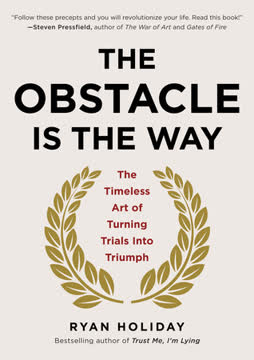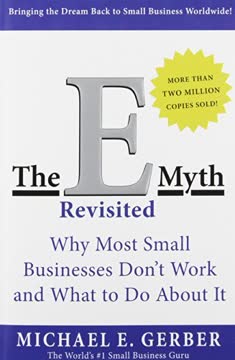Key Takeaways
1. Awakening the Entrepreneur Within: The Birth of a Dream
"The awakening to the mystery of life is a revolutionary event; in it an old world is destroyed so that a new and better one may take its place, and all things are affected by the change."
Entrepreneurial awakening is a transformative experience that often begins with a moment of clarity or inspiration. This "sudden seeing" can come from unexpected places, such as a casual conversation or a new perspective on an existing problem.
- Signs of entrepreneurial awakening:
- Increased awareness of opportunities
- Heightened creativity and problem-solving ability
- Passionate desire to create something new
The journey of entrepreneurship starts with recognizing and nurturing this inner spark, allowing it to grow into a fully-formed dream that can change the world.
2. The Four Dimensions of the Entrepreneurial Personality
"There are four dimensions of the entrepreneurial personality that come into play in the creation of a new venture: the Dreamer, the Thinker, the Storyteller, and the Leader."
Understanding these dimensions is crucial for entrepreneurial success. Each plays a vital role in the creation and growth of a business:
- The Dreamer: Envisions possibilities and generates innovative ideas
- The Thinker: Analyzes and plans, turning dreams into actionable strategies
- The Storyteller: Communicates the vision and inspires others to join the cause
- The Leader: Takes charge and drives the mission forward
Successful entrepreneurs learn to harness and balance these four aspects of their personality, knowing when to lean on each dimension as they navigate the challenges of building a business.
3. Personal vs. Impersonal Dreams: The Power of Purpose
"To the entrepreneur, the success of the invention—the business—is measured by growth. The faster the business grows, the more successful is the invention."
Impersonal dreams fuel successful entrepreneurship. While personal dreams focus on self-gratification, impersonal dreams aim to solve problems and create value for others.
- Characteristics of impersonal dreams:
- Focused on serving customers and solving problems
- Driven by a larger purpose beyond personal gain
- Potential for significant growth and impact
Entrepreneurs who pursue impersonal dreams are more likely to create businesses that scale and make a lasting impact on the world. By aligning their vision with a greater purpose, they tap into a wellspring of motivation and inspiration that can sustain them through the challenges of building a business.
4. The Sudden Shock: Recognizing Entrepreneurial Opportunities
"It happens to every one of us at one or more times in our life. If we're lucky, that is. What happens is a sudden shock."
Opportunity recognition often comes as a sudden realization or "shock" that reveals a gap in the market or a new way of solving a problem. This moment of clarity can be the catalyst for entrepreneurial action.
Key aspects of the sudden shock:
- Unexpected insights into existing problems or markets
- Recognition of unmet needs or inefficiencies
- Clarity about how to create value in a new way
Entrepreneurs must remain open and attentive to these moments of inspiration, as they can be the genesis of groundbreaking business ideas. The ability to recognize and act on these opportunities is a crucial skill for aspiring entrepreneurs.
5. From Dream to Vision: Shaping Your Business Model
"A business model simply describes the way a business makes money."
Crafting a viable business model is essential for turning entrepreneurial dreams into reality. It involves defining how your business will create, deliver, and capture value.
Key components of a business model:
- Value proposition: What unique benefit do you offer customers?
- Customer segments: Who are your target customers?
- Revenue streams: How will you generate income?
- Key resources and activities: What do you need to deliver your value proposition?
- Cost structure: What are the main costs in your business?
Developing a clear and compelling business model helps entrepreneurs validate their ideas and plan for sustainable growth. It serves as a roadmap for turning the initial vision into a profitable enterprise.
6. The Art of Storytelling: Crafting Your Entrepreneurial Narrative
"The Story always begins with 'Let me tell you who we are and what we do.'"
Effective storytelling is crucial for entrepreneurs to communicate their vision, inspire others, and attract customers, investors, and team members. A compelling narrative can bring your business idea to life and create emotional connections with your audience.
Elements of a powerful entrepreneurial story:
- Clear articulation of the problem you're solving
- Vivid description of your solution and its impact
- Personal anecdotes that illustrate your passion and commitment
- Vision for the future and how others can be part of it
Practice telling your story in various settings and to different audiences. Refine it based on feedback and learn to adapt it to different contexts while maintaining its core message and authenticity.
7. Leadership and Mission: Bringing Your Vision to Life
"The Leader is the one who assumes responsibility for moving the Dream forward, takes accountability for fulfilling the Dream, for knowing where he is going, how he is going to get there, when he's going to get there, and what the venture will look like when it gets there."
Effective leadership is essential for translating entrepreneurial vision into reality. Leaders must not only inspire and guide their team but also take responsibility for executing the mission.
Key leadership responsibilities:
- Setting clear goals and expectations
- Building and motivating a strong team
- Making tough decisions and solving problems
- Adapting to changing circumstances while staying true to the vision
Successful entrepreneurs develop their leadership skills alongside their business, learning to balance visionary thinking with practical execution. They create a culture that aligns with their mission and empowers their team to contribute to the shared goal.
8. The Wisdom of Process: Developing Your Business Strategy
"The wisdom of the process is to begin it."
Strategic planning is crucial for turning entrepreneurial ideas into actionable plans. It involves breaking down the vision into concrete steps and milestones.
Key elements of business strategy development:
- Setting clear, measurable objectives
- Analyzing the market and competition
- Identifying key resources and capabilities
- Developing action plans for each area of the business
- Establishing metrics to track progress
Remember that strategy is an ongoing process. Be prepared to adapt and refine your approach as you gain new insights and face unexpected challenges. The key is to start with a solid plan and remain flexible as you move forward.
9. Overcoming Doubts and Challenges in Entrepreneurship
"The challenge of the negative reaction is that it can kill your imagination. It can kill it immediately because it finds within you not only the entrepreneur who has awakened so slightly, but the dark side of the entrepreneur—the one who knows that this dream that is waking you up is a fantasy that threatens to destroy you."
Self-doubt and external skepticism are common challenges for entrepreneurs. Recognizing and overcoming these obstacles is crucial for maintaining momentum and achieving success.
Strategies for overcoming doubts:
- Acknowledge fears and doubts, but don't let them paralyze you
- Seek support from mentors and like-minded individuals
- Focus on small wins to build confidence
- Continuously educate yourself and improve your skills
- Remember your purpose and the impact you want to make
By developing resilience and maintaining a growth mindset, entrepreneurs can push through challenges and turn setbacks into opportunities for learning and improvement.
10. The Golden Pyramid: Scaling Your Business from One to Many
"The Revelation of the Golden Pyramid is that you can start your revolution from exactly where you are."
The Golden Pyramid strategy provides a framework for scaling a business from a single practice to a large enterprise. It emphasizes starting small, perfecting your model, and then replicating it.
Steps in the Golden Pyramid strategy:
- Identify your core skills and services
- Choose a specific customer category to focus on
- Develop deep expertise in serving that niche
- Create systems and processes to deliver consistently excellent results
- Replicate your model in new locations or markets
By following this approach, entrepreneurs can build a solid foundation for growth, minimizing risks while maximizing the potential for success. The key is to start with what you know, perfect it, and then scale it systematically.
Last updated:
FAQ
What's "Awakening the Entrepreneur Within" about?
- Entrepreneurial Awakening: The book focuses on how ordinary people can awaken the entrepreneur within themselves to create extraordinary companies.
- Dreaming Room Concept: It introduces the concept of the "Dreaming Room," a space where individuals can explore and develop their entrepreneurial dreams.
- Four Dimensions: The book outlines the four dimensions of the entrepreneurial personality: the Dreamer, the Thinker, the Storyteller, and the Leader.
- Practical Guidance: It provides practical guidance on transforming a personal dream into a viable business venture.
Why should I read "Awakening the Entrepreneur Within"?
- Inspiration for Entrepreneurs: The book is a source of inspiration for those looking to start their own business or transform their existing one.
- Unique Approach: Michael E. Gerber offers a unique approach to entrepreneurship that combines creativity with practical business strategies.
- Comprehensive Framework: It provides a comprehensive framework for understanding and developing the entrepreneurial mindset.
- Real-Life Examples: The book includes real-life examples and stories that illustrate the principles discussed.
What are the key takeaways of "Awakening the Entrepreneur Within"?
- Importance of Dreaming: Emphasizes the importance of dreaming and imagination in the entrepreneurial process.
- Systematic Approach: Advocates for a systematic approach to business development, focusing on creating replicable systems.
- Role of the Entrepreneur: Highlights the role of the entrepreneur as an inventor who creates opportunities rather than buying them.
- Personal vs. Impersonal Dreams: Differentiates between personal dreams and impersonal dreams that focus on creating value for others.
How does Michael E. Gerber define the "Dreaming Room"?
- Creative Space: The Dreaming Room is a creative space where individuals can explore their entrepreneurial ideas without constraints.
- Focus on Imagination: It emphasizes the use of imagination to envision new possibilities and business opportunities.
- Structured Process: The Dreaming Room provides a structured process for developing and refining entrepreneurial dreams.
- Foundation for Business: It serves as the foundation for building a business that is both innovative and impactful.
What are the "Four Dimensions of the Entrepreneurial Personality" according to Gerber?
- The Dreamer: Focuses on envisioning what could be and creating a compelling dream for the future.
- The Thinker: Analyzes how to turn the dream into reality, focusing on practical implementation.
- The Storyteller: Communicates the vision and purpose of the business to inspire others.
- The Leader: Takes responsibility for executing the vision and leading the business to success.
How does Gerber differentiate between personal and impersonal dreams?
- Personal Dreams: These are self-centered and often lead to temporary satisfaction without long-term fulfillment.
- Impersonal Dreams: Focus on creating value for others and have the potential to lead to sustainable business success.
- Long-Term Impact: Impersonal dreams are more likely to have a lasting impact and contribute to the greater good.
- Entrepreneurial Success: Gerber argues that true entrepreneurial success comes from pursuing impersonal dreams.
What is the "Golden Pyramid" strategy in the book?
- Economy of One: Starts with the individual and their unique skills and capabilities.
- Scalable Practice: Develops a practice that can be replicated and scaled to create a larger business.
- Systematic Growth: Emphasizes the importance of systems and processes in scaling a business.
- Enterprise Vision: Aims to build a large, impactful enterprise from a single, well-defined practice.
What role does storytelling play in "Awakening the Entrepreneur Within"?
- Communicating Vision: Storytelling is crucial for communicating the vision and purpose of the business.
- Inspiring Others: A compelling story can inspire employees, customers, and investors to support the business.
- Building Brand: The story helps build the brand and differentiate the business in the marketplace.
- Emotional Connection: Storytelling creates an emotional connection with the audience, making the business more relatable.
What are some of the best quotes from "Awakening the Entrepreneur Within" and what do they mean?
- "The System is the Solution": Emphasizes the importance of creating systems that ensure consistent business performance.
- "The Dreamer dreams about results": Highlights the focus on achieving tangible outcomes rather than just the process.
- "An entrepreneur invents new businesses": Stresses the role of the entrepreneur as a creator of opportunities.
- "The Dreaming Room is serious, serious work": Underlines the commitment required to turn dreams into reality.
How does Gerber suggest handling the "Negative Reaction" in entrepreneurship?
- Recognize Doubts: Acknowledge the doubts and fears that arise when pursuing a new venture.
- Focus on the Dream: Stay focused on the dream and the vision, using them as motivation to overcome obstacles.
- Embrace Challenges: View challenges as opportunities for growth and learning.
- Seek Support: Surround yourself with supportive individuals who believe in your vision.
What is the significance of the "Five Realities of the Entrepreneur" in the book?
- Invention Over Opportunity: Entrepreneurs create opportunities rather than buying them.
- Contagious Invention: A successful business idea can inspire and attract others.
- Growth as Success: Business success is measured by growth and impact.
- Universal Entrepreneurial Ability: Everyone has the potential to be an entrepreneur with the right mindset and skills.
- Practice and Patience: Developing entrepreneurial skills requires practice and patience.
How does "Awakening the Entrepreneur Within" address the concept of leadership?
- Purpose-Driven Leadership: Leaders must have a clear purpose and commitment to their mission.
- Standards and Results: Leaders should establish clear standards and focus on achieving results.
- Inspiring Others: Effective leaders inspire and motivate others to contribute to the business's success.
- Continuous Learning: Leaders must be open to learning and adapting to new challenges.
Review Summary
Awakening the Entrepreneur Within receives mixed reviews. Some readers find it inspiring and insightful, appreciating Gerber's discussions on entrepreneurial roles and common mistakes. Others criticize it as repetitive, unfocused, and lacking practical advice. The book explores the four dimensions of entrepreneurial personality: Dreamer, Thinker, Storyteller, and Leader. While some praise its motivational content and big-picture thinking, others feel it's filled with fluff and self-promotion. Overall, opinions vary widely, with ratings ranging from 1 to 5 stars.
Similar Books










Download PDF
Download EPUB
.epub digital book format is ideal for reading ebooks on phones, tablets, and e-readers.










